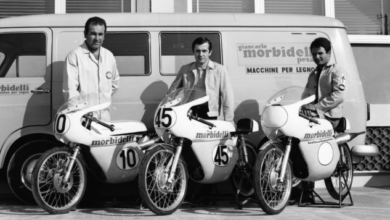Oct. 13, 2008 – Q&A: Product planning challenges during uncertain economic times
DALLAS — Patrick Kelly, director of product planning and research for Kawasaki Motors Corp., U.S.A., sat down with Powersports Business to discuss the company’s timing on the introduction of its luxury touring motorcycle; sales expectations for its supersport lineup in 2009; Teryx inventory concerns; and how much of an effect the recent collapse of the nation’s financial sector will have on Kawasaki and the powersports industry.
Powersports Business: What kind of growth potential do you see with your new luxury touring motorcycle, especially considering the current economic downturn?
Patrick Kelly: The Voyager’s return has been a very highly anticipated event. At virtually every event we go to where we have displays and interact with customers, the customers kept asking when was Kawasaki going to bring them a Nomad (a fairing and a trunk and radio), and what they were describing is the bike you see today. It was to the point where you couldn’t talk to any of our customers without hearing that. And our dealers were saying the same thing because they were hearing it from their customers too.
So for us, even though the market is down and there’s no question the economy is hurting, we have a great product in this bike. The touring and cruising market combined is more than half of the entire motorcycle industry. So it’s a huge market, and even though it’s a little bit tough right now, we have to get in there and get what we can with the best products we can. For us, we never gave any thought to “well the economy is down so let’s not do this.” For one thing, the development of this bike has been in the works for four years at least. And we did a ton of research before we came to market with this bike to find out what our customers wanted, and I believe we did a good job of hitting it on the head.
PSB: Do you expect the discretionary income of Baby Boomers to help fuel sales of this bike?
Kelly: Absolutely. The Baby Boomer population is still huge but they’re not going to be around forever, and we need to take advantage of the larger discretionary income they have while we can. We went out and talked to consumers in that older age range and asked them what’s the next bike they’re going to purchase, and a majority of them told us they were planning on buying a full-dressed bike. We feel like it is the right product and it’s a good time for us to introduce this into the market.
PSB: Let’s change gears and focus on the sport bike segment of the market. Where do you see the biggest growth potential in that segment?
Kelly: We believe that the supersport segment will not only be a significant area of growth in the short term, but also for the future. We want to get those consumers on a Kawasaki today and keep them on one for their riding career. I think you can see that
with the Ninja 250 that we brought out last year, and we basically couldn’t build enough of them to meet demand. We rebuilt our popular 650 Ninja this year, along with some other models. We view the supersport bike segment as extremely important in terms of growth potential.
PSB: During the meeting it was mentioned that some dealers were struggling with excess inventory of Teryx side-by-sides, and the company is now offering special Teryx financial packages to help resolve the problem. Is there any concern on your part that the side-by-side market might be waning?
Kelly: No, the RUV market is very strong and healthy, and we’ll continue to see growth there. I don’t think it’s immune to the current economic situation, but we view any reports of negative sales as merely a temporary slowdown. I wouldn’t even go as far as to say there’s a decline. I know Yamaha’s Rhino sales were down, but I think part of that is the economy, and another is that the Rhino has more competition now than in the past, so it’s not unexpected that there would be some impact on its sales.
We feel like Teryx sales are going to continue to rise. They’ve been rising steadily since we first introduced it to the market last year. It continues to pick up momentum and do well. Some of our dealers in certain areas of the country have done better than other dealers. And it takes awhile for a new product to get a good reputation and gain some momentum, but we think it’s going to continue to grow, and we made some significant upgrades to it this year to make it even more appealing to the end user and we expect nothing but a bright future for that segment.
PSB: With the recent crisis that unfolded on Wall Street, how much of a direct impact do you believe it will have on Kawasaki’s business, or is it too far removed from the retail sector that it doesn’t concern you?
Kelly: I think we’d have to be deaf, dumb and blind not to be concerned about the negative events that have occurred in the financial sector recently. Even the current financial situation, which doesn’t even take into effect what happened the past few days, has really dampened the buying power of some of our customers.
People who would have bought in the past can no longer finance or get credit to buy a product and the situation on Wall Street isn’t going to help things at all. But we feel the American people are very resilient, and none of us like to be in an economic slowdown and the second things look a little better, people are going to start buying again. I really believe that. So we’re going to continue to roll out the new products and come at the market with some good programs and pricing to support the product. We did see quite an increase in sales last year on some of our more economical motorcycles, and we expect that to continue for a while longer. So that will help support our motorcycle business. It all evens out. Some of our business is definitely down, but others areas are up tremendously. So in the end, we’re still in a solid position financially. psb




